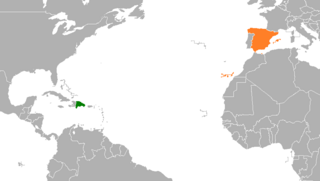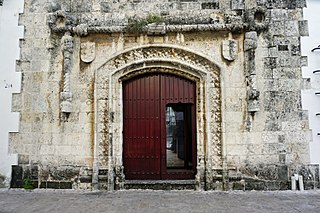
The Dominican Republic is a country located on the island of Hispaniola in the Greater Antilles archipelago of the Caribbean region. It occupies the eastern five-eighths of the island, which it shares with Haiti, making Hispaniola one of only two Caribbean islands, along with Saint Martin, that is shared by two sovereign states. The Dominican Republic is the second-largest nation in the Antilles by area at 48,671 square kilometers (18,792 sq mi), and third-largest by population, with approximately 10.8 million people, of whom approximately 3.3 million live in the metropolitan area of Santo Domingo, the capital city. The official language of the country is Spanish.

The recorded history of the Dominican Republic began in 1492 when the Genoa-born navigator Christopher Columbus, working for the Crown of Castile, happened upon a large island in the region of the western Atlantic Ocean that later came to be known as the Caribbean. It was inhabited by the Taíno, an Arawakan people, who called the eastern part of the island Quisqueya (Kiskeya), meaning "mother of all lands." Columbus promptly claimed the island for the Spanish Crown, naming it La Isla Española, later Latinized to Hispaniola. The Taínos were nearly wiped out due to European infectious diseases. Other causes were abuse, suicide, the breakup of family, famine, the encomienda system, which resembled a feudal system in Medieval Europe, war with the Castilians, changes in lifestyle, and mixing with other peoples. Laws passed for the Indians' protection were never truly enforced.

Santo Domingo, once known as Santo Domingo de Guzmán and Ciudad Trujillo, is the capital and largest city of the Dominican Republic and the largest metropolitan area in the Caribbean by population. As of 2022, the Distrito Nacional had a population of 1,484,789, while the total population is 2,995,211 when including the metropolitan area. The city is coterminous with the boundaries of the Distrito Nacional, itself bordered on three sides by Santo Domingo Province.
A Real Audiencia, or simply an Audiencia, was an appellate court in Spain and its empire. The name of the institution literally translates as Royal Audience. The additional designation chancillería was applied to the appellate courts in early modern Spain. Each audiencia had oidores.
Juan Ortiz de Matienzo was a Spanish colonial judge and a member of the first Real Audiencia in the New World, that of Santo Domingo, in 1512. From December 9, 1528 until January 9, 1531, he was a member of the First Audiencia of Mexico City, which was the governing body of New Spain during that period.

The Captaincy General of Venezuela, also known as the Kingdom of Venezuela, was an administrative district of colonial Spain, created on September 8, 1777, through the Royal Decree of Graces of 1777, to provide more autonomy for the provinces of Venezuela, previously under the jurisdiction of the Audiencia of Santo Domingo and then the Viceroyalty of New Granada. It established a unified government in political (governorship), military, fiscal (intendancy), ecclesiastical (archdiocese) and judicial (audiencia) affairs. Its creation was part of the Bourbon Reforms and laid the groundwork for the future nation of Venezuela, in particular by orienting the province of Maracaibo towards the province of Caracas.

The New Kingdom of Granada, or Kingdom of the New Granada, was the name given to a group of 16th-century Spanish colonial provinces in northern South America governed by the president of the Royal Audience of Santafé, an area corresponding mainly to modern-day Colombia. The conquistadors originally organized it as a province with a Royal Audience within the Viceroyalty of Peru despite certain independence from it. The audiencia was established by the crown in 1549. Ultimately the kingdom became the Viceroyalty of New Granada first in 1717 and permanently in 1739. After several attempts to set up independent states in the 1810s, the kingdom and the viceroyalty ceased to exist altogether in 1819 with the establishment of the United Provinces of New Granada.

Ciudad Colonial is the historic central neighborhood of the Dominican Republic's capital Santo Domingo. It is the oldest continuously inhabited European-established settlement in the Americas. The area has been declared a World Heritage Site by UNESCO. It is also known as Zona Colonial or more colloquially as "La Zona".

The Captaincy General of Santo Domingo was the first colony in the New World, established by Spain in 1492 on the island of Hispaniola. The colony, under the jurisdiction of the Real Audiencia of Santo Domingo, was granted administrative powers over the Spanish possessions in the Caribbean and most of its mainland coasts, making it the principal political entity of the early colonial period.
The Real Audiencia of Santo Domingo was the first court of the Spanish crown in America. It was created by Ferdinand V of Castile in his decree of 1511, but due to disagreements between the governor of Hispaniola, Diego Colon and the Crown, it was not implemented until it was reestablished by Charles V in his decree of September 14, 1526. This audiencia would become part of the Viceroyalty of New Spain upon the creation of the latter two decades later. Nevertheless, the audiencia president was at the same time governor and captain general of the Captaincy General of Santo Domingo, which granted him broad administrative powers and autonomy over the Spanish possessions of the Caribbean and most of its mainland coasts. This combined with the judicial oversight that the audiencia judges had over the region meant that the Santo Domingo Audiencia was the principal political entity of this region during the colonial period.

The Alcázar de Colón, or Columbus Alcazar is the first fortified Spanish palace built in the Americas. It is located in the Dominican Republic's colonial area of Santo Domingo city, and forms part of the Ciudad Colonial UNESCO's World Heritage Site. It was built between 1511 and 1514 mostly in a Gothic and Renaissance style.

The Reales Atarazanas is a waterside building that housed the shipyards, warehouses, customs house and tax offices of the old port of Santo Domingo, Dominican Republic. It was the property of the Spanish Crown. Begun in 1509, the Atarazanas is the oldest building of its type still standing in America, and one of a handful remaining in the Spanish world, amongst which are the Atarazanas Reales de Barcelona, in Barcelona, the Atarazanas Reales de Sevilla, in Seville and the Atarazanas del Grao in Valencia.
The Royal Audience and Chancery of Panama in Tierra Firme was a governing body and superior court in the New World empire of Spain. The Audiencia of Panama was the third American audiencia after the ones of Santo Domingo and Mexico. It existed three times under various guises since it first creation in 1538 until its ultimate abolition in 1751.
The following is a timeline of the history of the city of Santo Domingo in the Dominican Republic.

Campuzano Polanco was a prominent family from the colony of Santo Domingo with origins in Santiago de los Caballeros. During the colonial era of the Hispaniola, their members and descendants went on to occupy high political, military and ecclesiastical positions, locally and outside the Island, as well as in the metropolis of Spain. Their merits extend since the beginning and until the end of the colony.

Dominican Republic–Spain relations refers to the diplomatic relations between the Dominican Republic and Spain. Both nations are members of the Association of Academies of the Spanish Language and the Organization of Ibero-American States.

The Casa del Cordón is a property located in the Colonial City of Santo Domingo, in the Dominican Republic. It is the oldest European stone house in the Americas and probably the first European two-story house. Its name is due to the chiseled sash-and-cord that it presents on its façade, which is associated with the Franciscan Order. It is located on Isabel la Católica street with the corner of Emiliano Tejera.

The Casa de los Cinco Medallones is a Plateresque style house which was built in 1540. It is located in Santo Domingo, Dominican Republic.

The Casa del Sacramento, also called the Archbishop's House, is a colonial building located in Santo Domingo, Dominican Republic. It was built in 1523 by conquistador Diego Caballero, by the time secretary of the Real Audiencia of Santo Domingo, the house has two towers in the facade. On a time during the colony and now it is the residence of the Archbishop of Santo Domingo.
































